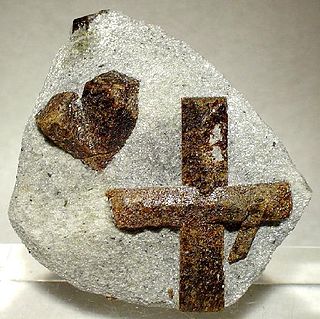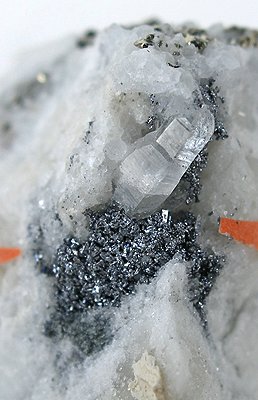
Arsenopyrite is an iron arsenic sulfide (FeAsS). It is a hard metallic, opaque, steel grey to silver white mineral with a relatively high specific gravity of 6.1. When dissolved in nitric acid, it releases elemental sulfur. When arsenopyrite is heated, it produces sulfur and arsenic vapor. With 46% arsenic content, arsenopyrite, along with orpiment, is a principal ore of arsenic. When deposits of arsenopyrite become exposed to the atmosphere, the mineral slowly converts into iron arsenates. Arsenopyrite is generally an acid-consuming sulfide mineral, unlike iron pyrite which can lead to acid mine drainage.

Zoisite, first known as saualpite, after its type locality, is a calcium aluminum hydroxy sorosilicate belonging to the epidote group of minerals. Its chemical formula is Ca2Al3(SiO4)(Si2O7)O(OH).

Astrophyllite is a very rare, brown to golden-yellow hydrous potassium iron titanium silicate mineral. Belonging to the astrophyllite group, astrophyllite may be classed either as an inosilicate, phyllosilicate, or an intermediate between the two. It forms an isomorphous series with kupletskite, to which it is visually identical and often intimately associated. Astrophyllite is of interest primarily to scientists and collectors.

Staurolite is a reddish brown to black, mostly opaque, nesosilicate mineral with a white streak. It crystallizes in the monoclinic crystal system, has a Mohs hardness of 7 to 7.5 and the chemical formula: Fe2+2Al9O6(SiO4)4(O,OH)2. Magnesium, zinc and manganese substitute in the iron site and trivalent iron can substitute for aluminium.

Acanthite is a form of silver sulfide with the chemical formula Ag2S. It crystallizes in the monoclinic system and is the stable form of silver sulfide below 173 °C (343 °F). Argentite is the stable form above that temperature. As argentite cools below that temperature its cubic form is distorted to the monoclinic form of acanthite. Below 173 °C acanthite forms directly. Acanthite is the only stable form in normal air temperature.

Adamite is a zinc arsenate hydroxide mineral, Zn2AsO4OH. It is a mineral that typically occurs in the oxidized or weathered zone above zinc ore occurrences. Pure adamite is colorless, but usually it possess yellow color due to Fe compounds admixture. Tints of green also occur and are connected with copper substitutions in the mineral structure. Olivenite is a copper arsenate that is isostructural with adamite and there is considerable substitution between zinc and copper resulting in an intermediate called cuproadamite. Zincolivenite is a recently discovered mineral being an intermediate mineral with formula CuZn(AsO4)(OH). Manganese, cobalt, and nickel also substitute in the structure. An analogous zinc phosphate, tarbuttite, is known.

Cobaltite is a sulfide mineral composed of cobalt, arsenic, and sulfur, CoAsS. It naturally appears in the form of a tetartoid, a form of dodecahedron with chiral tetrahedral symmetry. Its impurities may contain up to 10% iron and variable amounts of nickel. Structurally, it resembles pyrite (FeS2) with one of the sulfur atoms replaced by an arsenic atom.

Pyrargyrite is a sulfosalt mineral consisting of silver sulfantimonite, Ag3SbS3. Known also as dark red silver ore, ruby blende, garnete blende or ruby silver, it is an important source of the metal.

Stephanite is a silver antimony sulfosalt mineral with formula: Ag5SbS4. It is composed of 68.8% silver, and sometimes is of importance as an ore of this metal.

Enargite is a copper arsenic sulfosalt mineral with formula Cu3AsS4. It takes its name from the Greek word enarge, "distinct". Enargite is a steel gray, blackish gray, to violet black mineral with metallic luster. It forms slender orthorhombic prisms as well as massive aggregates. It has a hardness of 3 and a specific gravity of 4.45.

Nagyágite is a rare sulfide mineral with known occurrence associated with gold ores. Nagyágite crystals are opaque, monoclinic and dark grey to black coloured.
Alloclasite, or (Co,Fe)AsS, is a sulfosalt mineral. It is a member of the arsenopyrite group. Alloclasite crystallizes in the monoclinic system and typically forms as columnar to radiating acicular prismatic clusters. It is an opaque steel-gray to silver-white, with a metallic luster and a black streak. It is brittle with perfect cleavage, a Mohs hardness of 5 and a specific gravity of 5.91–5.95.

The mineral zektzerite is a member of the tuhualite group and was first found in 1966 by Seattle mineralogist Benjamin Bartlett "Bart" Cannon. It was discovered in the Willow creek basin below Silver Star mountain in miarolitic cavities within the alkaline arfvedsonite granite phase of the Golden Horn batholith, Okanogan County, Washington. It is named for Jack Zektzer, mathematician and mineral collector of Seattle, Washington.

Trithioarsenite, also called sulfarsenite, is the trianion AsS3−3. It is a pyramidal anion, as is typical of other AsIIIX3 compounds. It is generated by treatment of As2S3 with a sulfide:

Marrite (mar'-ite) is a mineral with the chemical formula PbAgAsS3. It is the arsenic equivalent of freieslebenite (PbAgSbS3), but also displays close polyhedral characteristics with sicherite and diaphorite. Marrite was named in honor of geologist John Edward Marr (1857–1933) of Cambridge, England.

The silver antimonide mineral dyscrasite has the chemical formula Ag3Sb. It is an opaque, silver white, metallic mineral which crystallizes in the orthorhombic crystal system. It forms pyramidal crystals up to 5 cm (2.0 in) and can also form cylindrical and prismatic crystals.

Pearceite is one of the four so-called "ruby silvers", pearceite Cu(Ag,Cu)6Ag9As2S11, pyrargyrite Ag3SbS3, proustite Ag3AsS3 and miargyrite AgSbS2. It was discovered in 1896 and named after Dr Richard Pearce (1837–1927), a Cornish–American chemist and metallurgist from Denver, Colorado.

Lautite is a rare mineral belonging to the class of sulfides and sulfosalts with the general formula CuAsS. It is orthorhombic and is known to form up to 2.3 cm long prismatic or flat crystals. It is also found as grains or masses.

Fülöppite is a rare member of the plagionite group, comprising heteromorphite Pb7Sb8S19, plagionite Pb5Sb8S17 and semseyite Pb9Sb8S21. It was named in 1929 for Dr. Béla Fülöpp (1863–1938), a Hungarian lawyer, statesman and mineral collector.

Arsenic blende or Arsenblende — a trivial name that has partially fallen out of scientific use, used by mineralogists, as well as representatives of mining and craft professions in relation to at least two similar ore minerals — orpiment and realgar, in composition — arsenic sulfides.



![The structure of proustite can be viewed as the Ag derivative of [AsS3] . Proustite.jpg](http://upload.wikimedia.org/wikipedia/commons/thumb/a/a9/Proustite.jpg/267px-Proustite.jpg)


















